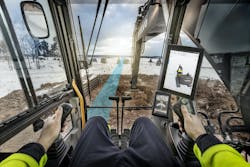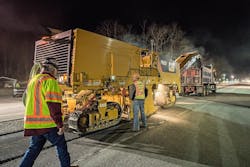A Primer on Intelligent Machines
On April 17 in Firestone, Colo., some 30 miles north of Denver, natural gas leaked from an underground flow line (a pipe that transfers gas from wells to processing or storage facilities) and seeped into a nearby home. The explosion left two fatalities. Colorado’s state legislature subsequently drafted a bill that would require oil and gas companies to inform the state where pipelines are located and for the state to create an online mapping database for the public.
According to Jon McKendry, product manager, site and utility construction, Civil Engineering and Construction for Trimble, technology is available today that would allow a hydraulic excavator to assist in buried utility mapping. For example, he says, the company’s new Earthworks platform has a “record-point” function that, when tapped, allows the system to remember a northing, easting, and elevation for the bucket focus at that location. The information then can be processed by office software to ensure that the utility has been placed according to design and serves as a reference for easily navigating back to that point.
Trimble’s Earthworks is an aftermarket, 3D, semi-automatic grade-control system that allows the machine to follow a programmed design. When close to the finished grade, operators can hold a trigger on the joystick while pulling in the stick, and the system automatically controls the boom and bucket to leave the grade at the design target.
In a similar development, Komatsu, in 2014, working with Topcon Positioning Systems, produced its first “intelligent” excavator, equipped with a semi-automatic grade-control system with both an Auto Grade Assist feature, which can automatically adjust the boom height, allowing the bucket to trace the design surface, and an Auto Stop Control, which automatically stops the working equipment when the bucket teeth reach the design surface, thus preventing over- or under-cutting the design.
Pervasive intelligence
The above examples serve as illustrations of how machine intelligence continues to advance. And intelligence is pervasive. Relatively inexpensive skid steer loaders, for instance, have the “intelligence” to follow a 3D grading plan when equipped with a grader box that’s guided by a multi-constellation GNSS (global navigation satellite system) network, and some skid steer models also are smart enough to change hydraulic-implement or hydrostatic-drive response at the operator’s command.
Many asphalt rollers have the ability to continuously monitor, display, and record mat stiffness and temperature, as well as pass counts, in real-time, and some models also can automatically change the drum’s amplitude or force vectors to avoid over-compaction as material stiffness increases.
BOMAG’s Bert Erdmann, director of engineering/product manager for heavy compaction, cites the company’s EcoMode system, used in certain of its rollers, as another intelligent feature. The system, he says, detects the horsepower requirement of the roller during operation and adjusts engine speed on the fly to conserve fuel and to reduce engine noise—the latter a significant factor for operator comfort.
In concrete-paving applications, machines become smart when working under the 3D control of such systems as Topcon’s LPS Paving System or Trimble’s PCS900 Paving Control, which use multiple robotic stations, on-machine sensors, and proprietary software. Using a road or surface design loaded into the slipform paver’s control system, the machine receives automatic steering and grade-control commands that keep it working within the design’s specifications at sub-centimeter vertical accuracies. No string lines required.
In mines, shovels equipped with the Caterpillar Load Positioning System display an intuitive graphic in the cab that shows the shovel operator—in real time—where weight is centered in the truck as each bucket load is added. The system, says Caterpillar, assists in proper, consistent loading, which allows the truck to function as designed and promotes driver safety, optimum payloads, extended tire life, and predictable maintenance.
Or when haul-truck drivers are in short supply for working in remote or hostile environments, “smart-machine” technology could be the answer. Komatsu’s Frontrunner Autonomous Haulage System, for example, is currently available for its 830E, 930E, and 980E mining trucks. Under development at Komatsu is the Innovative Autonomous Haulage Vehicle (IAHV), displayed at the 2016 MINExpo show. Designed with no operator’s cab and featuring four-wheel drive, braking, and steering systems, the IAHV will operate as a shuttle truck, eliminating the need to maneuver in the loading and dumping areas.
According to Caterpillar, its Cat Command for Hauling system allows certain of its mining-truck models to “respond to calls to the shovel, move into position, haul to dump points, and even report for maintenance—all without an operator on board.” Caterpillar is expanding autonomous technology to other of its truck models, as well as to competitive models as a retrofit option.
Machines can be smart, of course, in more mundane ways. Some hydraulic excavators, for example, have given up operator-selected working modes and simply use built-in logic to observe the operator’s use of the joystick controllers, then instantaneously use that information to adjust machine hydraulics for, say, boom-raise priority or swing priority. Some excavators are smart enough, also, to memorize the pressure/flow requirements for multiple attachments and to call up the correct specs when it recognizes that the tool is on the coupler.
For hydrostatic dozers, intelligence comes from such systems as John Deere’s SmartGrade and Komatsu’s Intelligent Machine Control. These dozers are equipped with integrated 3D grade-control systems, and when working in an automatic mode are smart enough to constantly measure resistance on the blade and to adjust blade height to keep the machine moving efficiently without track slip.
Grade control and telematics
For most equipment users, machine intelligence comes closest to practical application on job sites through grade-control and telematics systems.
Many of the “smart machines” cited above possess their intelligence via machine-control systems. These systems typically are classified as “indicate-only” or “automatic.” The former provide real-time, in-cab guidance (via the monitor) that allows operators to manually control the work tool according to a design loaded into the system. Automatic systems work in a similar fashion, except that an interface with the machine’s implement hydraulic system allows the grade-control system to automatically position the work tool.
Today, grade-control systems are available for virtually all major pieces of construction equipment. Systems are available in the aftermarket and, increasingly, as factory-integrated systems for widely used machines, such as dozers, motor graders, and hydraulic excavators. Some manufacturers also offer “system-ready” packages from the factory to facilitate installation of aftermarket systems.
As with technology in general these days, grade-control technology keeps advancing. Topcon and Trimble, for example, have new systems for dozers, 3D-MCMAX and Earthworks, respectively, which use devices called “inertial measurement units” that, compared with previous system designs, allow significantly faster machine operation with more precise control.
The payoff for investing in grade-control technology can be significant, given that the systems can significantly reduce rework, staking, and grade checking.
“We typically see 30 to 50 percent increases in productivity when [grade-control] technology is introduced to a base machine,” says Trimble’s McKendry, “depending on the machine type, the type of work, and the skill of the operator.”
Although grade control continues to gain adherents, a significant number of machine owners have not yet tried the technology, even though such systems are available in versions and price ranges that could suit most any situation. Also, an increasing number of systems incorporate intuitive, in-field design capability that simplifies creating designs for the machine to follow.
“Technology in earthmoving and site work changes too frequently to be ignored,” says Ron Oberlander, senior director, professional services, for the Topcon Positioning Group. “Contractors must continually seek out new information, learn from others, and take advantage of training opportunities as often as they can to remain competitive.”
In summary, grade-control systems can be 2D indicate, 2D automatic, 3D indicate, or 3D automatic—2D meaning that the location of the machine’s cutting edge is reported relative to a single reference—a laser or sonic tracer, for example. Or, in some instances, as with Volvo Construction Equipment’s Dig Assist excavator system, for example, the operator sets a reference point with a bucket tooth, then inputs the target depth and grade. “From there,” says Volvo, “the operator can visualize the bucket and the machine’s position in real time, alongside indicator guide lines that provide a ‘follow-the-line’ reference point for trenching.”
With 3D systems, the cutting edge is precisely located in space—with northing and easting coordinates and a specific elevation—and is guided by a digital map telling the machine what function is to be performed at that location.
Telematics
Most equipment managers are aware by now that many of their machines have a factory-installed telematics system, which collects all manner of data from sensors placed throughout the machine and wirelessly transmits these facts—along with satellite-based location information—to the machine manufacturer’s telematics website.
There, owners can view the data, pinpoint machine location, set up “fences” that limit a machine’s operation to specific times and geographical areas, and create reports that provide usable information of immediate economic value. Those reports, for example, might help avoid a rental by spotting a machine that hasn’t run for weeks on a job, or, might help to identify machines that are idling excessively and wasting fuel, while they also unproductively consume hour-meter time that eats up warranty coverage and lowers resale value.
Telematics systems also can be set up to monitor maintenance intervals (advising the dealer that service is due and what parts to bring), as well as to immediately notify the dealer (or the machine owner, or both) if a machine sends a fault code that requires immediate attention. Other benefits of these systems include, for example, the ability to monitor fuel burn, which could help identify an engine with a problem or an operator who needs added training. Or, receiving a message about a machine’s excessive brake usage could mean an operator who isn’t using (or doesn’t know how to use) a truck’s retarder.
The point is, a significant number of machine users are, for one reason or another, ignoring the value of the telematics system that is embedded in their machine—a system for which they have paid in the price of the machine and the use of which is usually free of charge from the manufacturer, typically for a number of years.
A few fleet managers and equipment dealers—early adopters of the technology, mostly—have not only learned the value of telematics for monitoring machine health and status, but also have learned to integrate telematics data into their business systems and to use this information across various disciplines. But such users are in the minority.
The best advice the industry has regarding telematics systems is that machine managers who have so far not investigated the technology should make it point to talk to a knowledgeable dealer and the dealer’s manufacturer’s rep about how using simple telematics data points, machine hours, for example, could be of great value.

